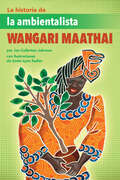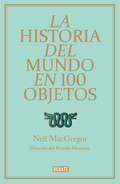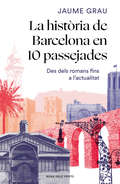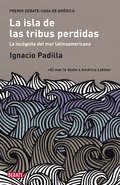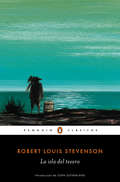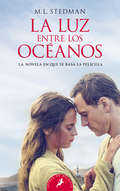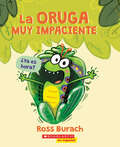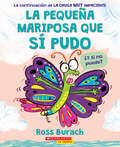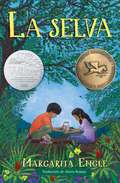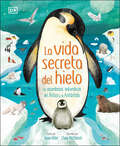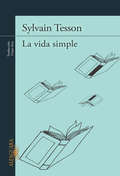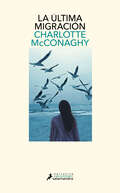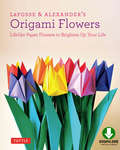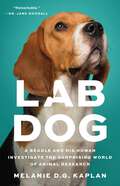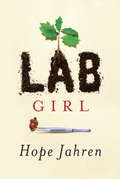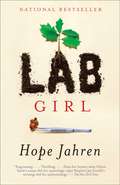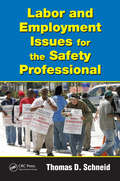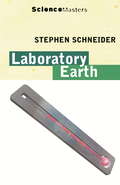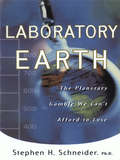- Table View
- List View
La historia de la ambientalista Wangari Maathai (The Story of Environmentalist Wangari Maathai)
by Jen Cullerton JohnsonEsta entrada inspiradora en la series de "Historia" de libros por capítulos biográficos se enfoca en Wangari Maathai, la primera mujer africana, y ambientalista, a ganar el Premio Nobel de Paz. This inspiring entry in the "Story of" line of chapter-book biographies features Wangari Maathai, the first African woman, and environmentalist, to win a Nobel Peace Prize.Wangari creció amando la naturaleza alrededor de ella en Kenia: desde los árboles mugumo hasta el río y los renacuajos que nadaban en él. Aunque muchas mujeres en Kenia no recibían educación, la familia de Wangari apoyó su curiosidad y pudo aprender muchas cosas maravillosas sobre el medio ambiente en cursos de ciencia. Sus estudios la llevaron lejos de su hogar, pero cuando vio que el Gobierno de su país estaba maltratando sus amados mugumos y el río, ella regresó con un plan. Sus ideas protegieron el ecosistema y a la vez promovieron los derechos de sus paisanas, y la hicieron la primer mujer africana y ambientalista a ganar el Premio Nobel de Paz. La historia de dedicación de Maathai empoderadá a todos los que amen las bellezas que ofrece el mundo natural. Este libro por capítulos incluye ilustraciones en blanco y negro, así como barras laterales sobre temas relacionados, una línea detiempo, un glosario y lecturas recomendadas. Perfecto para lectores que buscan pasar de libros ilustrados al siguiente nivel de lectura. Wangari grew up loving the nature around her in Kenya: from the mugumo trees to the river and the tadpoles that swam within it. Though many women in Kenya didn't receive an education, Wangari's family supported her curiosity and she was able to learn many wonderful things about the environment in science classes. Her studies took her far from home, but when she saw that her country's government was mistreating her beloved mugumos and river, she came back with a plan. Her ideas protected the ecosystem and promoted her countrywomen's rights at the same time, and they made her the first African woman and environmentalist to win the Nobel Peace Prize. The story of Maathai's dedication will empower all who love the beautiful things the natural world offers. This chapter-book edition includes black-and-white illustrations as well as sidebars on related subjects, a timeline, a glossary, and recommended reading. Perfect for readers looking to move from picture books to the next reading level.Check out the other titles in this series:LA HISTORIA DEL HÉROE DE LOS DERECHOS CIVILES JOHN LEWIS • LA HISTORIA DE LA ESTRELLA DE CINE ANNA MAY WONG
La historia de la nieve: La ciencia de la maravilla del invierno (¡Arriba la Lectura!, Read Aloud Module 6 #2)
by Mark Cassino Jon Nelson Nora AoyagiNIMAC-sourced textbook
La historia del mundo en 100 objetos
by Neil MacgregorEste libro ofrece un enfoque único de la historia de la humanidad a través del estudio de objetos que las distintas civilizaciones, a menudo sin pretenderlo, han ido dejando a su paso. Estas obras se convierten en una suerte de prismas a través de los cuales podemos explorar mundos antiguos y conocer algo más sobre las vidas de los hombres y mujeres que los habitaron. El campo de estudio que abarca es enorme, comienza con el primer objeto fabricado por manos humanas que se conserva, una herramienta para cortar procedente de la Garganta de Olduvai, en África, y termina con un objeto del siglo XXI que representa el mundo en el que vivimos hoy en día.El propósito de Neil Mac Gregor no es ofrecer una mera descripción de estos valiosísimos objetos sino mostrarnos su significado: cómo una columna de piedra nos habla sobre un gran emperador indio que predicaba tolerancia a su pueblo, cómo monedas españolas de ocho, acuñadas en Potosí, nos explican los orígenes de una moneda global, o cómo un juego de té de la época victoriana nos revela cuál fue la importancia del imperio.Cada capítulo sumerge al lector en una civilización pasada y lo acompaña con una guía de excepción. Vista de este modo, la historia es un caleidoscopio, cambiante, interrelacionado, sorprendente, que configura nuestro mundo contemporáneo de un modo que la mayoría de nosotros nunca habríamos imaginado. Un festín para el intelecto y para la vista, uno de los libros de historia más originales y fascinantes que se han publicado en años.
La història de Barcelona en 10 passejades: Des dels romans fins a l'actualitat
by Jaume Grau MasbernatDes de la ruta de l'aigua, de les revoltes, de les guerres o de les epidèmies fins a la ruta del treball, de les obres i especulació o la Barcelona màgica, Jaume Grau ens convida a caminar per la ciutat per descobrir tota la seva història. La millor manera de conèixer Barcelona és caminant-la. En els seus carrers i places hi ha escrita tota la seva història i només cal obrir bé els ulls per descobrir-la. La Barcelona d'avui és el testimoni viu de les Barcelones d'ahir, i en les seves pedres ha quedat imprès un relat històric apassionant. Les deu rutes temàtiques que proposa Jaume Grau per recórrer la ciutat es poden fer caminant, cadascú seguint el seu pas, o, fins i tot, dissenyant el seu propi trajecte. Des de la ruta de l'aigua, de les revoltes, de les guerres o de les epidèmies fins a la ruta del treball, de les obres i de l'especulació o de la Barcelona màgica, l'autor ens convida a mirar-la a través de la història.Una ciutat que amaga molts més racons i curiositats dels que ens hauríem pogut imaginar, com saber per exemple què hi fa una sabata a la façana de la catedral. Però també ens revela un passat dur i difícil, com el que podem observar al turó de la Rovira, on centenars de barcelonins van instal·lar les seves barraques sobre els antics emplaçaments dels canons antiaeris, que defensaven la ciutat dels atacs de l'aviació italiana. Obriu les pàgines d'aquest llibre, passegeu, mireu i passeu-vos-ho bé: la ciutat que caminareu és única, «la gran encisera», com la va definir Joan Maragall. Ressenya:«Passejar amb el llibre a la mà, seguint un dels itineraris que proposa, ens apropa a aquest món ocult i sorprenentment molt viu d'una ciutat tan intensa com és Barcelona. Està molt bé veure els monuments i les atraccions barcelonines amb ulls de turista, però potser ja és hora d'anar una mica més enllà i mirar-se Barcelona amb els ulls de la Història, de la vida, en definitiva.»Enric Calpena
La isla de las tribus perdidas
by Ignacio Padilla«Un mundo abrumado por su propia naturaleza, visto a través de las metáforas del agua, surge ante nosotros en este ensayo deslumbrante que recorre la tradición literaria de todo un continente», así justificaba su fallo el jurado del III Premio Iberoamericano de Ensayo Debate-Casa de América. En efecto, La isla de las tribus perdidas es una elegante narración que sigue la estela de Ulises y retoma los motivos clásicos del naufragio, la tempestad, el barco o la isla, para contar cómo Latinoamérica se convierte sin quererlo en el reverso de Occidente. Una bella inmersión en las fuentes literarias americanas donde Gabriel García Márquez, Julio Cortázar, Jorge Luis Borges, Carlos Fuentes, Juan Carlos Onetti o Alejo Carpentier son las aguas en que se refleja la relación conflictiva de un continente con el mar, pues tanto le duele el mar a América Latina que decidió vivir de espaldas a él.
La isla del tesoro
by Robert Louis StevensonLa isla del tesoro (1883), una vibrante historia sobre la búsqueda de un tesoro enterrado, presenta el bien bajo la forma de Jim, un niño que se ve envuelto en la aventura y que a su vez debe descubrir por sí mismo la cara del bien y del mal entre sus bondadosos amigos y los piratas Pew y Long John Silver.
La isla del tesoro
by Robert Louis StevensonLa aventura iniciática de un joven en busca del tesoro perdido de un pirata. La novela de aventuras por excelencia. Jim Hawkins regenta, junto a sus padres, la posada Almirante Benbow. Su vida discurre tranquila entre la barra y las mesas hasta que, un día, un viejo marinero entra en su fonda acarreando un pesado cofre de madera que oculta un valioso mapa. . . De la noche a la mañana, el joven Jim se encuentra en la cubierta de La Hispaniola, rodeado de rudos mercenarios, ansiosos por encontrar el codiciado tesoro del capitán Flint. Durante la mayor hazaña de su vida, irá conociendo mejor a John «el Largo» Silver, el viejo pirata que lo empujó a la aventura, personaje fascinante y contrapunto perfecto al carácter sencillo e inocente de Jim. «Resume todo lo que yo le pido a la literatura. » Eduardo Mendoza
La luz entre los océanos
by M.L. StedmanPremio LIBRO DEL AÑO 2013 en Australia. Una historia sobre el amor y la pérdida y que ha sido llevada a la gran pantalla. Una mañana de abril de 1926, un bote encalla en la costa rocosa de una remota isla australiana. En su interior yacen un hombre muerto y un bebé que llora con desesperación. A su encuentro salen Tom Sherbourne, el farero, y su joven esposa, Isabel. Se han instalado en la isla para dejar atrás los horrores de la Primera Guerra Mundial, y lo único que ensombrece su felicidad es la incapacidad de tener hijos. Ante la impresión que les causa un ser tan frágil e indefenso, Tom e Isabel deciden seguir el dictado de sus corazones y adoptar a la criatura, sin notificar el hallazgo a las autoridades. Un par de años después, cuando llega a su conocimiento que la madre de la niña está viva y mantiene la esperanza de encontrar a su hija, las tensiones se desatan en la pareja. Isabel ya no concibe la vida sin la pequeña Lucy, pero la decisión que han de tomar y el sufrimiento de la madre biológica harán que los hechos se precipiten en una cadena de consecuencias imprevisibles. Reseñas:«Una historia hermosamente escrita sobre el amor y la pérdida, sobre el sentido del bien y el mal, y sobre lo que somos capaces de hacer por nuestros seres queridos.»The Boston Globe «Stedman atrapa al lector desde la primera página con exuberantes descripciones del hermoso y agreste paisaje, y con personajes inolvidables.»Booklist «Una novela extraordinaria e inolvidable.»The Guardian «Una novela de amor a un tiempo delicada y convincente.»The Sunday Times «Escrita con distinción [...], emocionante [...], de gran belleza.»USA Today «Stedman crea el contexto perfecto para que se desarrolle un desgarrador dilema moral [...]. Especialmente impresionante es la evolución, sutil y profunda, de los dos protagonistas.»Publishers Weekly «Estas vidas ajenas y distantes nos resultan cercanas y reconocibles.»The New Yorker «Stedman construye su novela en torno a un inteligente y conmovedor dilema moral.»Kirkus Reviews «Una lectura absorbente e inmensamente conmovedora.»Monica Ali, autora de Una vida posible
La miel (¡Arriba la Lectura! Level K #83)
by Julie HaydonNIMAC-sourced textbook <p><p> ¿Sabes cómo hacen la miel las abejas? ¿Sabes qué tarea cumple cada tipo de abeja? ¡Lee y lo sabrás!
La oruga muy hambrienta
by Eric CarleThe Spanish translation of The Very Hungry Caterpillar (Philomel) preserves the original simplicity and the appealing use of repetition and rhythm. The exquisite collage illustrations will delight children as a hungry caterpillar happily eats his way through pages of fabulous food and emerges a brilliantly colored butterfly.
La oruga muy impaciente (The Very Impatient Caterpillar)
by Ross BurachThis clever send-up of every child's biggest challenge -- being patient! -- is a STEM-friendly, laugh-out-loud comedy about metamorphosis.La divertida exploracion de Ross Burach de la metamorfosis te hara aletear de jubilo, y a la vez te brindara datos reales acerca de como las orugas se transforman en mariposas.Ross Burach's hilarious, tongue-in-cheek exploration of metamorphosis will make you flutter with glee, while also providing real facts about how caterpillars transform into butterflies.
La pequeña mariposa que sí pudo (The Little Butterfly that Could)
by Ross BurachWhat if I can't?¿En qué dirección están las flores? Por ahí, a 320 kilómetros. ¡¿Cómo voy a llegar tan lejos?! Vasovolando. ¿Puedo ire n avión? No. ¡Entonces no llegaré nunca! Esta simpática continuación de La oruga muy impaciente , de Ross Burach, es un cariñoso homenaje al esfuerzo de cada niño de perseverar ante los desafíos a la vez que una alegre lección sobre la migración de las mariposas. Recuerda: si no lo logras al primer intento, ¡vuela, vuela otra vez! Which way to the flowers?That way. 200 miles.How am I supposed to travel that far?!You fly.Can I take a plane?No. Then I'll never make it!This comical companion to Ross Burach's The Very Impatient Caterpillar pays loving homage to every child's struggle to persist through challenges while also delivering a lighthearted lesson on butterfly migration. Remember, if at first you don't succeed, fly, fly again!
La potencia del viento (¡Arriba la Lectura!, Level S #68)
by Jill BryantEl viento es aire en movimiento. Sirve para viajar y divertirse, y como fuente de energía renovable. Se cree que, en el futuro, el viento va a producir gran parte del suministro de la electricidad de todo el mundo. El viento también es un factor clave de fenómenos meteorológicos extremos, como los tornados y los huracanes. Ficción realista Nivel S • 2,837 palabras El viento es aire en movimiento. Sirve para viajar y divertirse, y como fuente de energía renovable. Se cree que, en el futuro, el viento va a producir gran parte del suministro de la electricidad de todo el mundo. El viento también es un factor clave de fenómenos meteorológicos extremos, como los tornados y los huracanes. Estudiamos el viento para aprovechar su potencia para generar energía, y también para proteger a las casas y otros edificios de las tormentas destructivas. NIMAC-sourced textbook
La selva (Forest World)
by Margarita EngleNow in Spanish, award-winning author Margarita Engle’s lively middle grade novel in verse about a Cuban-American boy who visits his family’s village in Cuba for the first time—and meets a sister he didn’t know he had. <P><P>Edver isn’t happy about being shipped off to Cuba to visit the father he barely knows. Yet now that travel laws have changed and it’s a lot easier for divided families to be reunited, his mom thinks it's time for some father-son bonding. <P><P>Edver doesn’t know what this summer has in store, but he’s definitely not expecting to meet a sister he didn’t know existed! Luza is a year older and excited to see her little brother, until she realizes how different their lives have been. Looking for anything they might have in common, they sneak onto the internet—and accidentally catch the interest of a dangerous wildlife poacher. Edver has fought plenty of villains in video games. Now, to save the Cuban jungle they love, he and Luza are going to have to find a way to conquer a real villain! <P><P>A Edver no le hace ninguna gracia que lo envíen a Cuba a ver al padre que apenas conoce. Sin embargo, ahora que las leyes de viaje han cambiado y es mucho más fácil reunir a las familias divididas, su mamá piensa que es hora de que padre e hijo pasen tiempo juntos. Edver no se imagina lo que le depara el verano, ¡pero definitivamente no espera conocer a la hermana que ni siquiera sabía que existía! <P><P>Luza es un año mayor y está muy entusiasmada por conocer a su hermanito, hasta que se da cuenta de cuán diferentes han sido sus vidas. A la busca de cualquier cosa que puedan tener en común, se meten en internet y accidentalmente atraen la atención de un peligroso cazador de animales salvajes. Edver ha luchado contra muchísimos villanos en los videojuegos. <P><P>Ahora, para salvar la selva que tanto quieren, ¡Luza y él tendrán que encontrar un modo de derrotar a un villano real!
La vida en el desierto (¡Arriba la Lectura!, Level J #21)
by Lloyd KajikawaEl desierto es un lugar my seco y caluroso. Aprende cómo viven los animales en el desierto NIMAC-sourced textbook
La vida secreta del hielo (The Magic and Mystery of the Natural World)
by Jason BittelAdéntrate en 'La vida secreta del hielo' y embarca en un viaje increíble por los polos de la tierra.Osos polares, pingüinos y hielo se deslizan por las páginas de este colorido libro, que combina hermosas ilustraciones y fotos para ayudar a los niños más entusiastas a aprenderlo todo sobre el Ártico y la Antártida. Desde ríos helados hasta volcanes antárticos, descubrirán la increíble vida secreta de las regiones polares de la Tierra. También descubrirán cómo pueden ayudar a cuidar el Ártico y la Antártida.'La vida secreta del hielo' lleva a los niños por un deslumbrante viaje bajo cero, mostrándoles cuán increíbles son los polos de la tierra, qué plantas y animales viven cerca de ellos y cómo podemos ayudarlos. Incluye una multitud de vida polar, además de datos sorprendentes sobre cómo se forman los icebergs, cómo los animales sobreviven en el frío helado y cómo los científicos estudian la Antártida.Enter the world of the Arctic and Antarctic for an incredible journey around Earth&’s icy poles.Polar bears, penguins, and ice glide across the pages of this colorful book, which combines gorgeous illustrations and photos to help young enthusiasts learn all about the Arctic and Antarctic. From icy rivers to Antarctic volcanoes, they&’ll discover the incredible secret life of Earth&’s polar regions. They&’ll also find out how they can help take care of the Arctic and Antarctic themselves.'La vida secreta del hielo' takes children on a fascinating sub-zero journey, showing them just how amazing Earth&’s poles are, which plants and animals live near them, and how we can help them. It includes a multitude of polar life, plus amazing facts on how icebergs are formed, how animals survive in the freezing cold, and how scientists study the Antarctic.
La vida simple
by Sylvain Tesson¿Y si la felicidad consistiera en despojarse de todo? Desde el momento en que supe que no podría hacer gran cosa para salvar al mundo, empecé a pensar en instalarme por un tiempo, solo, en una cabaña. Compré una isba de troncos, lejos de todo, en la orilla del lago Baikal. Allí, durante seis meses, a cinco días de marcha del pueblo más cercano, perdido en una naturaleza desmesurada, traté de ser feliz. Creo haberlo logrado. ¿Y si la libertad consistiera en adueñarse del tiempo? ¿Y si la felicidad fuera disponer de soledad, de espacio y de silencio... cosas de las que carecerán las generaciones futuras? La crítica ha dicho:«Uno de los libros más extraordinarios que recuerdo haber leído hace tiempo... De una hermosura pasmosa que atiende a la epifanía.»Ricardo Menéndez Salmón, La Nueva España «Un libro profundamente ecologista... ¡Imprescindible abordar su lectura con un lápiz y/o bloc de notas!»Antonio Lozano, Qué leer «El libro más estimulante de la nueva temporada literaria.»Metro «Una obra preciosa porque muestra el valor incalculable del tiempo que pasa... Una oda a la inmovilidad y el silencio.»Le Monde «El brío de su erudición y la riqueza de sus referencias se realzan con una verdad humana de insólita autenticidad... Un magnífico escritor que ha narrado su experiencia de felicidad.»La Croix «Cultura, buen humor y una profundidad genuina.»Livres Hebdo «Entre la aventura interior y el sueño de una vida salvaje... Un libro magnético.»Le Monde des Livres «Un libro fascinante que propone volver a un modo de vida que suprime lo inútil, que se concentra en lo esencial... Revolucionario.»La Repubblica «Mucho más que un libro: una propuesta vital.»Le Point «Una experiencia no sólo bella de leer, sino también útil para los tiempos de crisis.»Rolling Stone «El viajero más famoso de Francia ha descubierto que quedarse inmóviles puede ser una exploración aún más vertiginosa que dar la vuelta al mundo en bicicleta. Y lo cuenta en un maravilloso libro que ha tenido un éxito enorme en Francia.»Elle «Tesson suscita emociones arrolladoras... Un libro hermoso y profundo.»Fulvio Ervas, La Stampa
La última migración
by Charlotte McConaghyMejor libro del año según la revista TIME, más de 175.000 ejemplares vendidos. Una adictiva ficción distópica Franny Stone es el tipo de mujer incapaz de comprometerse. Sin embargo, cuando la naturaleza que adora comienza a desaparecer, no puede seguir por el mundo sin un destino. Dejando todo atrás, llega a Groenlandia para seguir a los últimos charranes árticos del mundo en su migración finalhacia la Antártida. Convence a Ennis Malone, capitán del Saghani, de que la acepte a bordo con la promesa de que las aves los llevarán a un sitio de pesca. Pero a medida que la historia de Franny comienza a desvelarse -una apasionada relación amorosa, una familia ausente y un crimen devastador-, queda claro que está persiguiendo algo más. La última migración es una novela fascinante sobre la capacidad de perdonarse, la resiliencia y la posibilidad de esperanza ante un mundo al borde del colapso. La crítica ha dicho:«Visceral e inquietante [...]. Una obra de ficción climática de primera categoría».The New York Times Book Review «Emocionante.... Al comprender cómo la naturaleza puede curarnos, McConaghy subraya por qué es urgente protegerla».TIME «Un libro doloroso y conmovedor, que resulta muy oportuno [...]. Sobre el amor, sobre tratar de entender y aceptar la criatura que existe dentro de nosotros mismos, y lo que significa ser un animal humano, para que podamos adaptar mejor nuestra propia naturaleza salvaje dentro del mundo».The Guardian «Una epopeya tentadoramente bella».Elle «Un fascinante híbrido de escritura sobre la naturaleza y ficción distópica, [...] Apasionante. [...] Al fusionar ficción climática y escritura sobre la naturaleza, la novela demuestra poderosamente los costes espirituales y emocionales de la destrucción del medio ambiente».The Economist
LaFosse & Alexander's Origami Flowers
by Richard L. Alexander Michael G. LafosseLaFosse & Alexander's Origami Flowers Kit contains a full-color 96-page instruction book with clear diagrams and photos. The 2-1/2 hour downloadable instructional video is an added bonus, where the authors demonstrate how to fold each project in the kit. The flower projects range from simple to challenging. A variety of techniques are presented which origami makers can modify to create their own combinations. With these designs you can make greeting cards, gift boxes, bouquets, and stunning jewelry.This new collection of paper folding projects includes many innovative flower models such as:A striking Rose for Irene with interlocking Calyx ModuleThe gracefully-curled Plumeria and Star Flowers The bold Modular Six-Piece Day Lily BlossomAuthors LaFosse and Alexander together founded Origamido Studio, a learning center and design studio specializing in exquisite handmade origami paper. Their works has appeared in window displays and museum exhibitions around the world, and are made available to a wider audience for the first time.
Lab Dog: A Beagle and His Human Investigate the Surprising World of Animal Research
by Melanie D.G. KaplanThe "remarkable" (Dr. Jane Goodall) story of a beagle&’s past, and the future of animal research When journalist Melanie D.G. Kaplan adopted her beagle Hammy, all she knew was that he had spent nearly four years in a research lab. Curious to know more about this gentle creature&’s past, as well as the broader world of animal research, Kaplan—with Hammy in tow—embarks on a quest for answers. How did Hammy end up in a research facility? Why are we still using millions of animals a year in experiments? What have we learned from them? Is there another way? In Lab Dog, Kaplan investigates the breeding and use of beagles for biomedical research, drug and product testing, and education. She takes readers on a journey, peeking behind laboratory doors and visiting with researchers, activists, ethicists, veterinarians, lawmakers, and innovators. Along the way, she finds thoughtful and caring humans on all sides of the debate, explores promising developments in nonanimal testing, and discovers puzzle pieces from Hammy&’s past. Equal parts journalism and love story, Lab Dog offers a nuanced view on our relationship with a species that we both love and exploit, and a reason to hope for a better future for all.
Lab Girl
by Hope JahrenAn illuminating debut memoir of a woman in science; a moving portrait of a long-time collaboration, in work and in life; and a stunningly fresh look at plants that will forever change how you see and think about the natural world.Acclaimed scientist Hope Jahren has built three laboratories in which she's studied trees, flowers, seeds, and soil. Her first book might have been a revelatory treatise on plant life. Lab Girl is that, but it is also so much more. Because in it, Jahren also shares with us her inspiring life story, in prose that takes your breath away. Lab Girl is a book about work, about love, and about the mountains that can be moved when those two things come together. It is told through Jahren's remarkable stories: about the things she's discovered in her lab, as well as how she got there; about her childhood--hours of unfettered play in her father's laboratory; about how she found a sanctuary in science, and learned to perform lab work "with both the heart and the hands"; about a brilliant and wounded man named Bill, who became her loyal colleague and best friend; about their adventurous, sometimes rogue research trips, which take them from the Midwest all across the United States and over the Atlantic, from the ever-light skies of the North Pole to tropical Hawaii; and about her constant striving to do and be the best she could, never allowing personal or professional obstacles to cloud her dedication to her work. Jahren's insights on nature enliven every page of this book. Lab Girl allows us to see with clear eyes the beautiful, sophisticated mechanisms within every leaf, blade of grass, and flower petal, and also the power within ourselves to face--with bravery and conviction--life's ultimate challenge: discovering who you are.From the Hardcover edition.
Lab Girl
by Hope JahrenA New York Times 2016 Notable BookNational Best SellerNamed one of TIME magazine’s "100 Most Influential People"An Amazon Top 20 Best Book of 2016A Washington Post Best Memoir of 2016A TIME and Entertainment Weekly Best Book of 2016 So Far An illuminating debut memoir of a woman in science; a moving portrait of a longtime friendship; and a stunningly fresh look at plants that will forever change how you see the natural world Acclaimed scientist Hope Jahren has built three laboratories in which she’s studied trees, flowers, seeds, and soil. Her first book is a revelatory treatise on plant life—but it is also so much more. Lab Girl is a book about work, love, and the mountains that can be moved when those two things come together. It is told through Jahren’s remarkable stories: about her childhood in rural Minnesota with an uncompromising mother and a father who encouraged hours of play in his classroom’s labs; about how she found a sanctuary in science, and learned to perform lab work done “with both the heart and the hands”; and about the inevitable disappointments, but also the triumphs and exhilarating discoveries, of scientific work.Yet at the core of this book is the story of a relationship Jahren forged with a brilliant, wounded man named Bill, who becomes her lab partner and best friend. Their sometimes rogue adventures in science take them from the Midwest across the United States and back again, over the Atlantic to the ever-light skies of the North Pole and to tropical Hawaii, where she and her lab currently make their home. Jahren’s probing look at plants, her astonishing tenacity of spirit, and her acute insights on nature enliven every page of this extraordinary book. Lab Girl opens your eyes to the beautiful, sophisticated mechanisms within every leaf, blade of grass, and flower petal. Here is an eloquent demonstration of what can happen when you find the stamina, passion, and sense of sacrifice needed to make a life out of what you truly love, as you discover along the way the person you were meant to be.
Labor and Employment Issues for the Safety Professional (Occupational Safety & Health Guide Series)
by Thomas D. SchneidAn examination of the safety laws and regulations, particularly in the areas of labor and employment, this book provides a working knowledge of the impacts, requirements, and implications of safety professionals' actions and inactions as related to state and federal laws. It presents information on an issue-by-issue basis and delineates the basics of the issue; identifies the applicable law or regulation; and presents possible solutions to achieve and maintain compliance while achieving the safety objective. The book covers conflicts between laws and regulations and includes case law and reference points.
Laboratory Earth (SCIENCE MASTERS)
by Stephen H SchneiderAn extremely readable account on the scientific essentials of the global warming debateThe possibility of global climatic change as a result of increasing numbers of people requiring higher stands of living has spawned an international controversy over the appropriateness of controls on deforestation and energy use. In order to address the political debate it is essential to understand the scientific background that underlies this problem. Laboratory Earth takes the reader on a journey from the dawn of earth's climate and biological evolution through the era of the dinosaurs, past the Ice Age and into the shadowy environmental future increasingly dominated by human activities. In the final analysis it will be human values more than scientific methods that must be applied to decide how to gamble with the fate of the earth.
Laboratory Earth: The Planetary Gamble We Can't Afford To Lose
by Stephen H. SchneiderLaboratory Earth taps the relevant knowledge from physical, biological, and social sciences needed to study the planet holistically. This so-called Earth Systems Science fosters a new way to understand the Earth and our roles as inhabitants, with the purpose of building solutions to the bewildering global environment and overdevelopment. Educational, business, health, and governmental organizations often dissect the world into narrow but highly specialized disciplines--economics, ecology, cardiology, meteorology, glaciology, or political science, to name a few. But real world problems, like urban sprawl, public health, poverty, toxic waste, economic development, the ozone hole, or global warming, do not fit neatly into disciplinary boxes. However, author Stephen Schneider asserts that these contemporary issues must be viewed as systems of interconnected subelements. This is especially true for global environmental problems, since they arise from increasing numbers of people demanding higher standards of living and willing to use the cheapest available technologies to pursue these growth-oriented goals, even if the unintended byproducts include land degradation, toxic pollutants, species extinctions, or global climate change. To first understand and then solve such problems, we must learn to view the Earth and our socioeconomic engine as one integrated system. Schneider, who in the 1970s predicted global warming would become "demonstrable” by the turn of the century, chooses that debate to illustrate how this twenty-first century Earth Systems Science approach works, introducing us to the sharp controversies and highly visible debates among climatologists, ecologists, economists, industrialists, and political interests over the seriousness and solutions to the climate change crisis. He begins with a fascinating journey to the beginning of geologic time on Earth and traces from there the coevolution of climate and life over the next four billion years. Along the way we learn about the Gaia Hypothesis, the demise of the dinosaurs, and the likelihood of an impending ice age. Schneider traces our climatic history not only from the beginning and up to the twentieth century, but deep into the twenty-first as well. He depicts the next one hundred years as a potentially perilous period for climate and life--unless we citizens of Earth recognize and then work to control the unintended global scale experiment we are foisting on ourselves and all other life on "Laboratory Earth. ” This "lab” is not built of glass, wires, and tubes, but of insects, soils, air, oceans, birds, trees, and people. While no honest scientist can claim to have clairvoyant vision into the twenty-first century, Schneider optimistically demonstrates that enough is already known to command our attention and to insure that the juggernaut of human impacts on Earth doesn’t turn into a gamble we can’t afford to lose.
